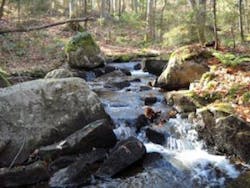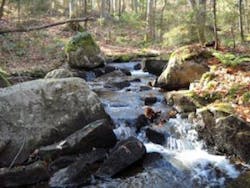Wetlands could be used to improve quality of acid streams, researchers say
Sept. 4, 2013 -- A team of biologists at the University of Texas at Arlington working with the U.S. Geological Survey (USGS) has found that watershed wetlands can serve as a natural source for the improvement of streams polluted by acid rain. The group, led by associate professor of biology Sophia Passy, contends that recent increases in the level of organic matter in surface waters in regions of North America and Europe -- also known as brownification -- holds benefits for aquatic ecosystems.
The authors of the study believe that as streams acidified by acidic deposition pass through wetlands, they become enriched with organic matter, which binds harmful aluminum and limits its negative effects on stream producers. Organic matter also stimulates microbes that process sulfate and nitrate and thus decreases the inorganic acid content. These helpful organic materials are also present in brownification -- a process that some believe is tied to climate change. The newly-published paper said that this process might help the recovery of biological communities from industrial acidification.
The team analyzed water samples collected in the Adirondack Park, a six million acre region in northeastern New York. The Adirondacks have been adversely affected by atmospheric acid deposition with subsequent acidification of streams, lakes and soils. Acidification occurs when environments become contaminated with inorganic acids, such as sulfuric and nitric acid, from industrial pollution of the atmosphere. Inorganic acids from the rain filter through poorly buffered watersheds, releasing toxic aluminum from the soil into the waterways. The overall result is loss of biological diversity, including algae, invertebrates, fish, and amphibians.
Working during key times of the year for acid deposition, the team collected 637 samples from 192 streams from the Black and Oswegatchie River basins in the Adirondacks. Their results compared biodiversity of diatoms, or algae, with levels of organic and inorganic acids. They found that streams connected to wetlands had higher organic content, which led to lower levels of toxic inorganic aluminum and decreased presence of harmful inorganic acids.
"Ecologists and government officials have been looking for ways to reduce acidification and aluminum contamination of surface waters for 40 years. While Clean Air Act regulations have fueled progress, the problem is still not solved," Passy said. "We hope that future restoration efforts in acid streams will consider the use of wetlands as a natural source of stream health improvement."
Passy joined the UT Arlington College of Science in 2001. Katrina L. Pound, a doctoral student working in the Passy lab, is the lead author on the study. The other co-author is Gregory B. Lawrence, of the USGS's New York Water Science Center.
Many have viewed brownification as a negative environmental development because it is perceived as decreasing water quality for human consumption. "What we're saying is that it's not entirely a bad thing from the perspective of ecosystem health," Pound said.
The UTA team behind the paper hopes that watershed development, including wetland construction or stream re-channeling to existing wetlands, may become a viable alternative to liming. Liming is now widely used to reduce acidity in streams affected by acid rain but many scientists question its long-term effectiveness.
###

